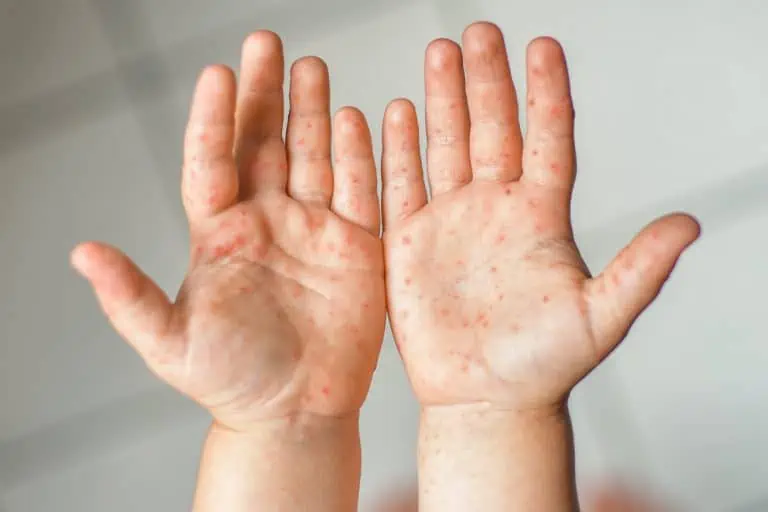Hand, Foot and Mouth Disease in Adults and Kids: Get the Facts

When your child develops an itchy rash in the summer or fall, you might first suspect poison ivy or heat rash, but there’s another potential culprit to consider: Hand, foot and mouth disease. This highly contagious viral infection usually occurs in children under age 5. Hand, foot and mouth disease in adults is less common and often causes mild symptoms or no symptoms.
What is hand, foot and mouth disease?
As you can guess from the name, hand, foot and mouth disease rash affects the hands, feet and mouth. It can also appear on other parts of the body, such as the diaper area, knees and elbows. The disease is caused by viruses that are part of the enterovirus family, which usually cause mild illnesses. In the United States, coxsackievirus A16 is to blame in most cases. Young children are more susceptible to hand, foot and mouth disease than adults in part because they haven’t yet developed immunity to these viruses.
Hand, foot and mouth disease symptoms
Different stages of hand, foot and mouth disease are associated with different symptoms. During the first day or two of infection, symptoms can include a sore throat, low fever, stomach pain and reduced appetite. A sick person is most contagious at this point.
Around day three, these symptoms go away and are replaced by:
- Mouth sores. The sores can develop anywhere in the mouth, or even the back of the throat, but they often appear on the tongue. At first they look like tiny bumps or bright pink spots, but they eventually become blisters, which can be painful. Swallowing may be uncomfortable, so young children may drool more than usual, refuse to eat or want only cold drinks.
- Itchy rash. The hand, foot and mouth disease rash looks like red, flat spots that quickly give way to bumps or small, red blisters that have fluid near the surface. The blisters scab over as they heal. Some children don’t develop a rash, only mouth sores.
- Swollen glands (lymph nodes) in the neck. Some people develop these, others don’t.
How the disease spreads
There are several ways to contract the virus. These include:
- Touching the blisters of someone who has it
- Kissing, hugging or sharing utensils with someone who has it
- Touching an infected child’s feces while changing their diaper and then touching your eyes, nose or mouth
- Touching objects contaminated with the virus, such as doorknobs or toys
- Breathing droplets expelled by an infected person’s cough or sneeze
The virus is particularly common in kids who attend daycare, for reasons you can well imagine — the toilet training and countless diaper changes that happen there, as well as small children’s fondness for putting their hands and objects in their mouth.
Treatment for hand foot and mouth disease
There is no particular treatment for the virus, which typically improves on its own in seven to 10 days. Adults can relieve a fever with aspirin, but infected children and teens should be given acetaminophen (Tylenol) instead.
These strategies can help soothe mouth sores:
- Avoid spicy, salty or acidic foods and beverages (such as orange juice and soda)
- Drink cold beverages
- Suck on ice cubes or popsicles
- Eat cold foods such as ice cream, sherbet or sorbet
- Swish warm salt water around the mouth several times day (for adults and for children who can avoid swallowing the water)
If mouth sores are particularly painful and the child is old enough to gargle, a doctor can prescribe a mouthwash that contains several beneficial ingredients, including a painkiller.
If an infected child is under six months old or has a weakened immune system, or if the symptoms are severe, go to a doctor. Contact your child’s pediatrician if the fever lasts longer than three days, symptoms don’t improve after 10 days or your child is dehydrated. Signs of dehydration in kids include dry lips, dark urine, decreased urination, and dizziness, fatigue or lightheadedness.
Any woman who gets hand, foot and mouth disease while pregnant should contact her doctor.
In very rare cases, hand, foot and mouth disease can lead to serious complications such as viral meningitis and encephalitis. Symptoms of meningitis include an extremely painful headache and neck stiffness. Encephalitis causes a painful headache and confusion. Loss of fingernails or toenails is another rare complication, but the nails usually regrow.
Medically reviewed by Andrew Jaffe, MD, FAAD
Written by Jessica Brown, a health and science writer/editor based in Nanuet, New York. She has written for Water’s Edge Dermatology, Prevention magazine, jnj.com, BCRF.org, and many other outlets.


